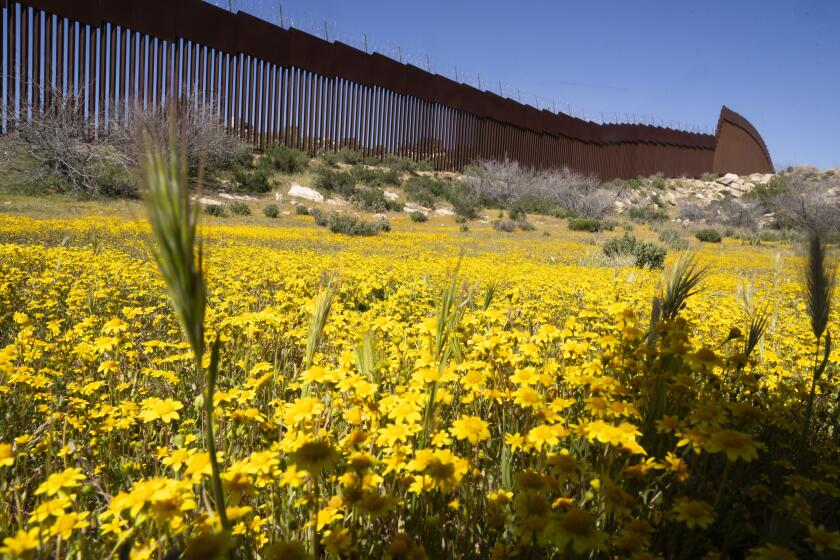Farm Groups Sound Warning of Impending Pickers’ Shortage
Despite liberalized guidelines announced this week, agricultural industry representatives, farm worker advocates and others say that U.S. immigration authorities must act quickly and more decisively to avert a serious shortage of farm workers in California and other states.
“The agriculture industry in California faces certain peril if present farm workers’ shortages are not immediately addressed,” U.S. Sen. Pete Wilson (R-Calif.) said Wednesday.
Wilson and other critics of the U.S. Immigration and Naturalization Service said revised INS regulations designed to alleviate the prospective shortage would fall far short of solving the problem.
Inch Instead of a Yard
“It’s one inch forward when we should have had a full yard,” said Bob L. Vice, a farmer in North San Diego County who is first vice president of the California Farm Bureau, an industry group. “It’s just a real Band-Aid approach.”
Principally, agricultural groups and others are calling on the INS to ease the requirement that farm workers seeking legal U.S. residence must now show considerable documentation to demonstrate their prospective eligibility. Critics maintain that farm workers cannot be expected to have “cumbersome” documentation on hand, but should be given time to remain in the United States legally while they round up past pay stubs and the other paper work required.
“I think most people don’t have that kind of evidence readily available,” said Linda Wong, associate counsel with the Mexican American Legal Defense and Education Fund in Los Angeles.
Under the Immigration Reform and Control Act of 1986, undocumented workers who have performed at least 90 days of farm work in the one-year period that ended on May 1, 1986, may be eligible to live legally in the United States. Applicants must show documentation such as pay stubs to demonstrate their eligibility. Congress included the relatively liberal 90-day requirement for legalization at the insistence of U.S. growers, who feared the kind of labor shortages that have already developed in the Pacific Northwest and show signs of happening in California.
However, since the application period for undocumented farm workers began June 1, fewer than 8,000 laborers have submitted applications nationwide--compared to the estimated 500,000 undocumented workers who harvest crops in the United States each year. Moreover, in Mexico, where most of the undocumented farm population resides full time, not a single application had been filed with the U.S. Embassy by the beginning of this week, according to Donna Sherman, a spokeswoman for the State Department’s Bureau of Consular Affairs.
Farmers Panicky
The paucity of applications, and the demonstrated shortage of farm workers in the Northwest this year, has left the California farm community panicky about the prospects of finding enough laborers to service the state’s $14-billion farm industry--the largest in the nation. Grapes and other major crops will be harvested in the coming weeks.
“Farmers are wondering by how much they’re going to lose their shirts,” said Barbara Buck, a spokeswoman for the Western Growers Assn.
In San Diego County, despite some scattered labor shortages, farmers have generally found enough workers, said Vice, of the farm bureau. He noted two factors: the region’s proximity to Mexico and its large supply of workers, and the fact that many farm laborers remain here year-round, working the area’s wide variety of crops.
“We haven’t felt them (shortages) as much,” Vice said.
Reacting to the potential crisis, the INS on Tuesday announced a series of steps designed to make it easier for farm workers now living in Mexico to qualify for temporary legal U.S. residence under the legalization program. To the disappointment of growers and others, the changes did not ease the documentation burden imposed on farm workers seeking legal residence here.
The three principal revisions announced Tuesday:
- Directed U.S. consulates in Monterrey and Hermosillo to begin accepting legalization applications from farm workers. Previously, applications could only be filed with the U.S. Embassy in Mexico City, a requirement that would have forced many applicants to travel hundreds or even thousands of miles before filing. However, critics maintain that all eight U.S. consulates in Mexico--particularly those in the border cities of Tijuana, Ciudad Juarez, Nuevo Laredo and Matamoros--should be empowered to accept legalization applications from farm workers.
- Delayed the cutoff date by which agricultural workers must have entered the United States in order to qualify for the new farm worker legalization program. The date was pushed back from May 1, 1987, to June 26, which is today. Farm groups and others have said that the cutoff date should be eliminated entirely, as there is no statutory requirement for such a deadline.
- Announced that farm workers seeking legalization under the law could submit applications at the U.S. port of entry at Calexico, Calif., the gateway to the rich farm area of the Imperial Valley. Critics say applications should be accepted at all major ports of entry at all major border crossings, especially the much-used crossings in heavily populated areas such as San Diego and El Paso, Tex.
More to Read
More to Read
More to Read
Get the L.A. Times Politics newsletter
Deeply reported insights into legislation, politics and policy from Sacramento, Washington and beyond. In your inbox three times per week.
You may occasionally receive promotional content from the Los Angeles Times.






